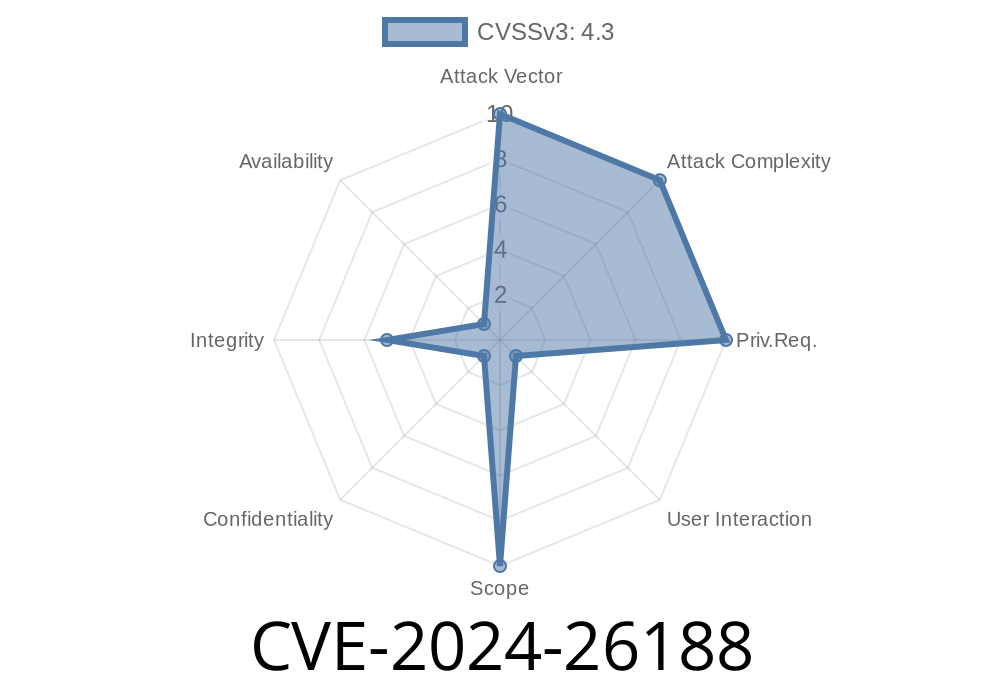In the world of cyber-security, CVE (Common Vulnerabilities and Exposures) identifiers play a crucial role in keeping track of software bugs and vulnerabilities that could be exploited by attackers. One such vulnerability was discovered in Microsoft's Edge (Chromium-based) browser, which has been assigned with the identifier CVE-2024-26188. In this article, we will dive deep into the details of this vulnerability, understand how it works, and look at the potential exploit implications.
Vulnerability Overview
The CVE-2024-26188 vulnerability exists in the Chromium-based version of Microsoft Edge, a popular browser with millions of users worldwide. It is specifically a spoofing vulnerability, which allows attackers to forge the content (e.g., web page URLs, site content, etc.) displayed to the user, leading them to believe they are accessing a legitimate website or domain. Spoofing can be a precursor to phishing attacks, enabling attackers to steal sensitive information or execute further attacks on the target.
Original References
The details of this vulnerability were brought to light by cybersecurity researchers, who responsibly disclosed their findings to Microsoft for further investigation. The official CVE database, maintained by MITRE Corporation, also documents this issue. The following links provide further insights into the vulnerability and its implications:
1. CVE entry: https://cve.mitre.org/cgi-bin/cvename.cgi?name=CVE-2024-26188
2. Microsoft Advisory: https://msrc.microsoft.com/update-guide/vulnerability/CVE-2024-26188
Exploit Details
To better understand how this spoofing vulnerability works, let's consider a simple example. Assume a user is trying to log in to their bank's website, but an attacker has taken advantage of the CVE-2024-26188 vulnerability. The attacker could create a fake login page that exactly mimics the real bank’s website and display it to the user. The user, unaware of the forgery, might then input their login credentials, which would be stolen by the attacker.
The vulnerability arises from the improper handling of certain characters or strings within the browser's rendering engine. The specific code snippet responsible for this vulnerability can be found within the 'url_formatter.cc' file in the Chromium source code repository. It would look similar to the following:
void FormatUrlInternal(const GURL& url,
const std::string& languages,
Parsed* parsed,
base::string16* url_string,
size_t* prefix_end) {
if (url.is_empty())
return; // Nothing to format.
// Remove HTTPS scheme, preserve a potential username and password.
if (url.SchemeIs(url::kHttpsScheme)) {
parsed->scheme.reset();
parsed->username.reset();
parsed->password.reset();
} else {
parsed->scheme = Component(, url.scheme().size()+3); // 3 = "://"
}
// Implement other functions here..
}
In this code snippet, we see that the HTTPS scheme is stripped from the URL, but the username and password components are not. This is one of the primary factors leading to the spoofing vulnerability. The attacker can manipulate specific characters in the URL to deceive the browser's rendering engine and trick it into displaying false information.
Mitigations and Recommendations
Upon discovering the vulnerability, Microsoft released patches and updates to fix the issue. Users are strongly advised to update their Microsoft Edge browser to the latest version to stay protected from potential exploits targeting CVE-2024-26188. Moreover, users should always stay cautious and vigilant when browsing online, and verify that they are indeed visiting a legitimate website before revealing sensitive information.
Conclusion
The CVE-2024-26188 vulnerability in Microsoft Edge (Chromium-based) highlights the importance of staying up-to-date with security patches and being aware of potential cyber risks. As cybercriminals continuously look for new avenues to exploit, it is essential for users and developers to prioritize security and protect themselves from potential harm.
Timeline
Published on: 02/23/2024 23:15:09 UTC
Last modified on: 02/26/2024 13:42:22 UTC
